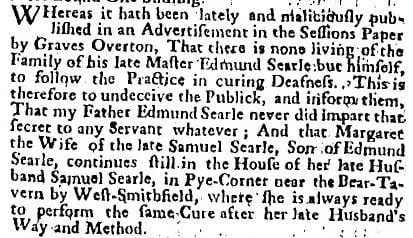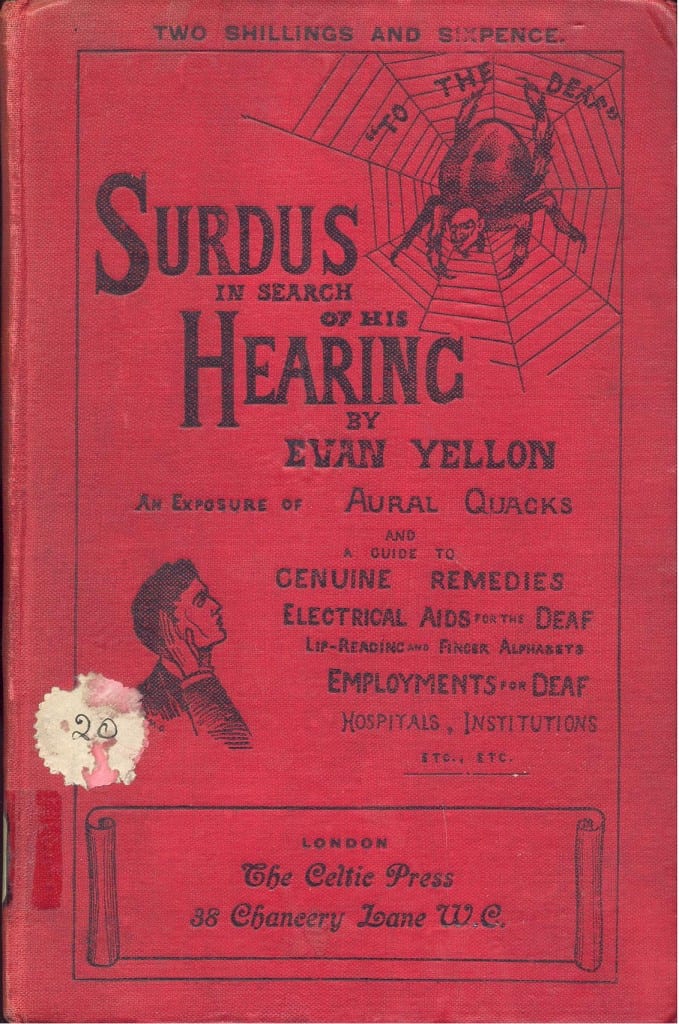“Edmond Searle, lately deceased, was so famous at curing all sorts of Deafness” – the Searls of Pye Corner & their Rival, Graves Overton
By H Dominic W Stiles, on 23 March 2018
Last year while searching for something completely different, I came across the name Margaret Searl or Searle, around 1700, in Smithfield, London. She has a brief mention in the excellent book by C.J.S. Thompson, The Quacks of Old London (Barnes and Noble, 1993). She was the last of her family it seems, who had carried out a business near Pye Corner, which is where the Great Fire of London ended. What we can glean from advertisements of the time, on Bills that survive and in contemporary newspapers, is that her father Edmund or Edmond, together with his nephew we must assume, Samuel, set up in business from at least 1668, ‘curing deafness.’ The first record I have come across for Edmund, is his burial on the 7th of July, 1695, at St. Sepulchre’s Church, Holborn, which is opposite the Old Bailey. His son, Samuel, was buried in the same church on the 17th of December, 1699.
Unfortunately for Samuel’s widow Margaret, who was I assume his cousin, a former servant or apprentice of Edmund’s, Graves Overton, gave out that Margaret was dead, and that he had the secret of the deafness cure [I reproduce the text with the orthography of the original] –
WHereas Mr. Edmond Searle, lately deceased, was so famous at curing all sorts of Deafness, this is therefore to Advertise all Persons that Graves Overton, his only Servant , lives at the Hand and Ear in Pye Corner, alias Gilt-spur-street, near Newgate, where he performs the same Cures by his Masters secret Method. There being now, none of his Masters Family living but himself, that performs the said Cure. (Friday the 1st. of March, 1700, Old Bailey Records)
Another advertisement says, “Graves Overton, who Cures Deafness and is the only Surviving Servant of Mr. Edmund Searle, who was famous in that art, lives at the Hand and Ear in Pye Corner, next Giltspur Street.” (May 29, 1701)
He must have had the first advertisement for a while in 1700, as a month before that, this riposte appeared in The Post Boy (Issue 753) refering to ‘The [Old Bailey] Sessions paper’ –
This ding-dong of rivalry must have gone on for a while. Here is the text of one of Margaret’s bills which survive –
Margaret Searl, Wife to the late Samuel Searl, Famous for Relieving and Curing deafness, Depending on any External Obstruction Of the Organ of the Ear; Who had Practised This art above Thirty Eight Years past, and Communicated the Secret to me only, who Practis’d it with him, in his Life time, for many Years, after the same Way and Method. Still living in Pye-Corner, over-against the Golden Ball, by West-Smithfield, London; (though it is Reported that I was Dead, by some Pretenders to deceive the World) where I am ready, upon any Occasion of that Nature, to serve such as apply themselves to me: Being the Surviver of my Father Edmund Searl, and late Husband Samuel Searl. Whereas several Servants of my Father Edmund Searl, have put out Bills for Curing of deafness. This is to Certifie, That neither my Father, or Husband, ever Instructed, or Communicated this Secret to any of their Servants, or any Apprentice whatsoever. (1706, 18th Century Collections Online)
When Overton’s daughter Mary was baptised, on 17/12/1693-1694, he was living with his wife Rebecca on Snow Hill, just around the corner, and they were still there when his son John was born in 1696. Overton had married Rebecca Walserd in Temple Church, on the 25th of November, 1692. Overton died in 1704, and was buried at St. Sepulchre’s on the 4th of March.
Poor Margaret Searl – the quacks multiplied, as they tend to, and it seems Overton was not her only rival, for in The Post Boy for January 16th, 1701, we read (with spellings accurately rendered),
WHereas Graves Overton does put out Bil’s for Curing of Deafness; This is to certify all People, that Mr. Edmund Searl declared before his death, that he never did instruct him in that Art, especially being a Turn-over to him, nor any other of his Apprentices that were bound to him, if they would have given Two hundred Pounds down, as can be Attested by several Persons. Neither did Mr. Samuel Searl ever instruct Thomas Lamb, his Brother-in-Law in Curing of Deafness, nor any thing but a Barber’s Trade, nor any other Person but his Wife, who (being the Survivor of those two famous Men) lives still at the Old House in Pye-Corner, who practis’d with her late Husband Samuel Searl in his Life-time, and now does after the same Way and Method with good success.
From this then we learn the not surprising fact that the Searls (also sometimes ‘Serle’) were barbers, the trade with which surgeons in England had a close association for 200 years. I wonder if he had any association with St. Bartholomew’s Hospital which is right opposite Pye Corner. At any rate, it is perhaps unfair to call them quacks as their deafness ‘cures’ were probably harmless, while a doctor of the time was far more likely to kill you.
Margaret Searl[e] was buried in St. Sepulchre’s on the 29th of March, 1709/10, and what became of the ‘cure’ we can only guess!
London Metropolitan Archives; London, England; Church of England Parish Registers, 1538-1812; Reference Number: P69/SEP/A/001/MS07219/003
Post Boy (1695) (London, England), February 3, 1700 – February 6, 1700; Issue 753.
Post Boy (1695) (London, England), March 12, 1700 – March 14, 1700; Issue 769.
Post Man and the Historical Account (London, England), September 24, 1700 – September 26, 1700
Post Boy (1695) (London, England), January 14, 1701 – January 16, 1701; Issue 901.
Post Boy (1695) (London, England), May 27, 1701 – May 29, 1701; Issue 940
Title: Samuel Searl, famous for relieving and curing deafness, depending on any external obstruction of the organ of the ear; Date: 1680-1689 Reel position: Tract Supplement / E8:1[75]
Title: Margaret Searl, wife to the late Samuel Searl, famous for relieving and curing deafness, … Date: 1706 Reel position: Tract Supplement / E8:2[59]
 Close
Close



